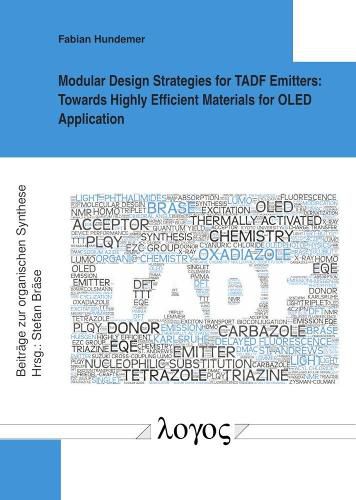Readings Newsletter
Become a Readings Member to make your shopping experience even easier.
Sign in or sign up for free!
You’re not far away from qualifying for FREE standard shipping within Australia
You’ve qualified for FREE standard shipping within Australia
The cart is loading…






Organic light-emitting diodes (OLEDs) are one of the most promising lighting technologies of the recent years not only due to their efficiency and energy saving capabilities, but also for their unique features in the realization of transparent and flexible display solutions. Thermally activated delayed fluorescence (TADF) is considered as the most promising mechanism for electroluminescence for OLED application as this allows a complete conversion of excitons to photons.
In this work, strategies for the development of TADF materials for solution processed OLED devices were pursued:
Isophthalonitrile- and phthalimide-based TADF emitters were chemically modified with derivatization on the acceptor and donor groups in order to study the structure-to-property relationships. A modular approach allowed the introduction of various functional groups and structural motives. Besides succeeding in attaching a TADF emitter to biomolecules and oligomers for various applications like fluorescence imaging, the optoelectronic properties were manipulated mainly with regards to the emission wavelength covering a total range of 437 nm to 541 nm with typically small increments of 2 nm. Most promising emitters were employed in solution processed OLED devices, resulting in external quantum efficiencies (EQE) of up to 16 %.
In addition, the tris[1,2,4]triazolo[1,3,5]triazine (TTT) core was successfully implemented as novel acceptor group for TADF emitters. Hence, a synthesis for the TTT core with peripheral donor groups was developed. The donor strength and count were identified as key drivers for the emission color (398 nm to 466 nm) and the dihedral angle as critical measure for TADF characteristics.
$9.00 standard shipping within Australia
FREE standard shipping within Australia for orders over $100.00
Express & International shipping calculated at checkout
Organic light-emitting diodes (OLEDs) are one of the most promising lighting technologies of the recent years not only due to their efficiency and energy saving capabilities, but also for their unique features in the realization of transparent and flexible display solutions. Thermally activated delayed fluorescence (TADF) is considered as the most promising mechanism for electroluminescence for OLED application as this allows a complete conversion of excitons to photons.
In this work, strategies for the development of TADF materials for solution processed OLED devices were pursued:
Isophthalonitrile- and phthalimide-based TADF emitters were chemically modified with derivatization on the acceptor and donor groups in order to study the structure-to-property relationships. A modular approach allowed the introduction of various functional groups and structural motives. Besides succeeding in attaching a TADF emitter to biomolecules and oligomers for various applications like fluorescence imaging, the optoelectronic properties were manipulated mainly with regards to the emission wavelength covering a total range of 437 nm to 541 nm with typically small increments of 2 nm. Most promising emitters were employed in solution processed OLED devices, resulting in external quantum efficiencies (EQE) of up to 16 %.
In addition, the tris[1,2,4]triazolo[1,3,5]triazine (TTT) core was successfully implemented as novel acceptor group for TADF emitters. Hence, a synthesis for the TTT core with peripheral donor groups was developed. The donor strength and count were identified as key drivers for the emission color (398 nm to 466 nm) and the dihedral angle as critical measure for TADF characteristics.